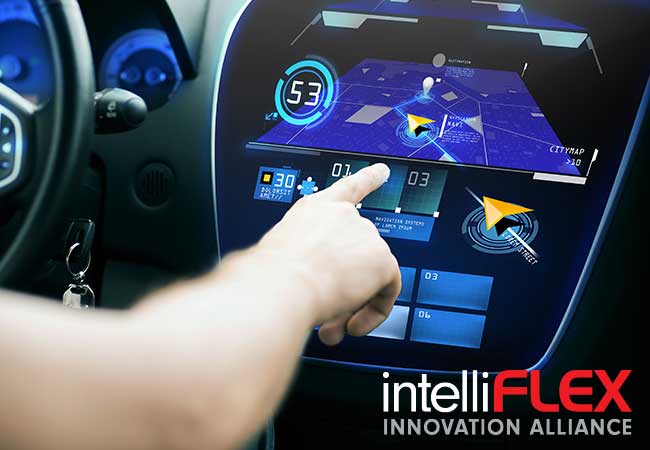By Mark Majewski
Remember when cars didn’t have touchscreen displays and Wi-Fi on a flight was a pipe dream?
That wasn’t so long ago, and now these technologies are commonplace. Digital transformation and connectivity is rapidly reshaping motorized transport on land, at sea and in the air.
This extends to applications for flexible and hybrid electronics (FHE). A 2016 report from IDTechEx forecast the global market for printed/flexible electronics in automotive applications to grow from a few hundred million dollars to more than US$5.5 billion in the span of a decade, driven by the growth of FHE technologies in-mould electronics and organic LEDs (OLEDs).
Why? Because of the same benefits FHE delivers for other applications – flexibility of design for a range of applications, low-cost, low-power and small physical footprint.
FHE components are already found in seat occupancy sensors and heating elements, electrochromic mirror and window glass, and touch screens. Audi, BMW and others are designing tail lights with OLEDs that are thinner, lighter and capable of far more stylish designs than conventional options. Jaguar Land Rover is pushing the boundaries of windshield projection and making the pillars between doors “transparent” with embedded screens. The health of the humble tire can now be monitored with printed sensors that could cost less than a penny each in mass production.
These applications aren’t just for wheels on the road, but for any form of motorized transport, included aerospace.
FHE applications gaining ground
Here are a few other examples of applications in use or in development:
- Occupancy sensing, control panels, hand-free communications systems and smart heads up displays for driver assist systems and, ultimately, autonomous vehicles.
- Smart environments for autonomous driving, with smart surfaces and sensor networks on the vehicles to sense the road and other vehicles and pedestrians, to “see” at intersections and to communicate with smart signs.
- Monitoring systems to ensure safe operation, with smart textile seat covers and flexible sensors in the controls that can detect drug or alcohol impairment and give an alert in case of a medical emergency.
- Lighter and more fuel-efficient vehicles thanks to FHE electronics such as lightweight printed cables, in-mould electronics-based dashboards, lighter OLED displays and printed antennas for communications between vehicle systems. FHE-based wiring and cabling can remove 100 kgs weight from the typical car. OLEDs and other FHE components also consume far less power than conventional lighting and electronics, reducing demands on the battery and potentially reducing battery weight.
- Alternative fuel and drive systems using organic photovoltaics. E-vehicles could generate some, even all, of their power needs with an energy-harvesting “skin.”
- Frequency selective surfaces and frequency targeting to improve wireless coverage in aircraft and passenger rail, or to block wireless interference from sensitive areas, like the cockpit.
Canada’s ecosystem is growing
Canada is well-positioned to take advantage of this growth market. About $1.2 billion worth of manufacturing output for motor vehicle electrical & electronic equipment did take place in Canada in 2014, according to the most recent data available from Statistics Canada. Thee development and adoption of new technologies gives this segment of our domestic manufacturing industry fuel to grow.
Many of our members are already active in this space. Companies like Myant with its smart fabrics that have in-vehicle applications, NanoCnet with its transparent conductive films for touch displays, OLEDs, solar cells and smart glass, OTI Lumionics with its OLED technologies, CTT Group, which has partnered with multinational defence and transportation giant Thales Group on smart seats, and the Communications Research Centre with its work on frequency selective surfaces.
FHE in transportation represents a substantial market opportunity for our members. That’s why intelliFLEX worked to align itself last summer with two of the proposals for the federal government’s $950-million Innovation Superclusters Initiative that focused on transportation technologies. These were the MOST 21 proposal [led by the Consortium for Aerospace Research and Innovation in Canada (CARIC) and the Automotive proposal [led by the Automotive Parts Manufacturers Association (APMA). (We are also working with the team behind the Advanced Manufacturing Supercluster proposal).
Regardless of which supercluster proposals make the final cut, we are discussing how best we can work together to foster collaborations between our members and automotive and aerospace manufacturers, to bring new products to market and drive Canada’s knowledge-based economy.
How we get around is undergoing a technological shift thanks to FHE that is every bit as profound as anything we see with consumer electronics. Canada has the pedigree in advanced manufacturing and transportation manufacturing to take full advantage of it.
